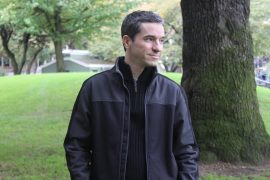On the evening of Thanksgiving, November 22, 2018, Mr. Richard Barry, aged 52, died soon after he was taken into custody by Portland State University’s campus police and Portland Police Officers. The medical examiner and district attorney both concluded Barry had a heart attack because of a poor heart condition and drug use. The death was ruled an accident, caused by “acute methamphetamine and cocaine toxicity,” and the officers are determined not at fault. Officer footage and records reviewed by The Pacific Sentinel raise questions about the circumstances and response around Barry’s death.
The incident involved four officers from PSU’s Campus Public Safety Office (CPSO): one armed sworn officer, David Troppe, and three unarmed campus safety officers, Michael Anderson, Danae Murphy and Nichola Higbee. (Only Troppe, as a sworn officer, carries a body camera.) The two Portland Police officers reportedly involved were James DeAnda and Jared Abby.
Official reports of the incident say that four CPSO officers and two Portland Police officers performed a “welfare check” in response to calls of a man yelling and running near SW 6th Avenue and SW Mill Street. According to the reports, six officers struggled to restrain Barry. Police said they requested emergency medical personnel “based on the subject’s behavior,” and that he was transported to the OHSU Emergency Department hospital for treatment of “an unidentified medical condition.” where he was pronounced dead.
The State Medical Examiner’s Office performed an autopsy investigation and on December 10th, 2018, reported that Barry died from “acute Methamphetamine and Cocaine toxicity.” Because the death was ruled an accident and unrelated to officer involvement, Multnomah County initially declined to release the full medical report. The report was made public after The Oregonian appealed the denial of records.
The Pacific Sentinel filed a public records request, and PSU’s Office of General Counsel released CPSO’s body camera footage and incident report to the public. The video footage offers further insight into the circumstances surrounding Barry’s death.
13 minutes of video footage taken by PSU Officer David Troppe’s body camera captured some of the events that preceded Barry’s death—from the moment CPSO encountered Barry up until Portland Police are about to arrive. Then, there is a three and a half minute lapse in the video’s visuals. When the visuals resume, Barry is surrounded by officers and restrained on his belly on the sidewalk. Barry resists until he seems to become unresponsive. The final four minutes of video show paramedics arrive on scene and prepare to restrain Barry on a backboard. No one seems to notice Barry isn’t moving or talking anymore. The video ends before first responders roll Barry onto a backboard.
Footage courtesy of PSU’s Office of General Council via public records request. Video contains sensitive content, viewer discretion is advised.
According to PSU’s Office of General Council, the only changes/redactions in the video are “the blurring of faces.” The office confirms that the entire video is 13:07 minutes in length, and that “yes it cuts off.”
The Medical Examiner’s report—the only full narrative available to the public by request—describes the events leading to Mr. Barry’s death. The report relies on accounts of the event and CPSO’s body camera footage for that narrative, but does not reveal or explain any lapse in footage. (Portland Police do not use body cameras, but PPB is implementing a body camera pilot program this summer to determine whether they will adopt “full implementation” in 2020.)
The Oregonian reported that a DA memo addressed the lapse in footage saying that Troppe’s body camera was knocked off and reattached. The CPSO incident report does not reveal or explain the lapse in footage. Nor does it mention any body camera issues. (CPSO/Campus Police Chief, Donnell Tanksley, has not responded to requests for comment on PSU’s body camera policy, the lapse of footage, or why the video stops during the interaction.)
Oregon’s body camera policy, HB 2571, says that the camera must continue recording until “the termination of the officer’s participation in the contact.” (HB 2571 applies to law enforcement agencies that use body cameras, but it does not require all law enforcement officers to wear body cameras.)
Here is what the video shows:
[Here is a link to a much more detailed description—minute by minute—of what can be seen and heard from Officer Troppe’s body camera.]
CPSO officers responded to Barry, clearly agitated, running and screaming in the street. “They got guns!” Barry behaves as though he has just fled from someone with a gun. His movements are erratic—jerking his head around to look over his shoulder, panting, occasionally pointing, always fidgeting. At one point, Barry appears to try to get into CPSO’s patrol car through the driver door that Troppe left open. Troppe pulls Barry away, closes the door, and instructs Barry to put his hands up on the vehicle while he searches Barry’s pockets. Troppe asks Barry if he has a gun. Barry answers no. Barry urgently tells Troppe to “put me in the back, lock me up,” but adamantly refuses to go to the sidewalk and get out of the street. “You’re going to shoot me, aren’t you?” Barry says suddenly before accusing Troppe and the safety officers of being “fake police,” of being “with them.” (It is unclear who “they” are.) Barry calls for help: “Help! Call the police!” he yells in the street over and over. At one point, Troppe has Barry by the wrist, but Barry lurches away and runs towards the intersection. Troppe is telling him to stop. Barry stops, turns around and says “Lock me up then!” Troppe and the officers struggle to take Barry by the arms and lead him to the sidewalk. There, Barry tries to wriggle free as he continues to cry out for help.
At minute mark 2:57, the video wobbles and goes black moments before Portland Police officers arrive. Barry is audible through the lapse of footage.
At minute mark 6:06, a voice says, “We’re going to need AMR—he’s all cut up on his head.”
At minute mark 6:37, the footage regains vision of bright lights that cast a figure’s shadow on the brick wall of St. Mary’s Academy. Troppe is handed the body camera and says, “Guys, I’ve got a video camera right here.” The footage spins around to reveal the scene on the sidewalk: Barry is prone on the sidewalk with his hands cuffed behind his back, Officer Troppe on his left leg, Campus Safety Officer Anderson by his right leg, a police officer over his shoulders, and three more officers standing a few feet away. His head is covered by his sweatshirt.
The videotape shows that Barry continues to resist. He tries to roll out from beneath the officer’s knee on his right shoulder. “Help me!” Barry grunts and groans.
A second police officer squats down by Barry’s left shoulder and says, “Calm down, buddy. We’ve got an ambulance coming.” He takes Barry by the sleeve of his left upper arm.
The videotape shows Barry writhing on the ground, moaning.
“Just keep it still, man,” one officer says.
“You’re OK, man,” the other officer says.
A few seconds later, at minute mark 8:03, Barry’s moans subside and his left little finger twitches.
For the remainder of the video, Barry is quiet and motionless, handcuffed and face down on the sidewalk.
For the next minute and a half, the officers talk to each other as they wait for paramedics to arrive. Troppe gives a brief summary of what happened before the police officers got there. The police officers regret that Barry’s blood got on their hats. “He’s on both of our hats,” one offers. “Well, my hat’s off to him,” the other responds.
At minute mark 9:35 of the video, the paramedics arrive and greet officers from off camera. By now, Barry hasn’t moved or spoken for a minute and a half. An officer tells the paramedics Barry is “gonna prolly need something to calm down.”
“What’s your name bud?” someone asks Mr. Barry. There is no reply. A person in beige pants and black shoes enters the frame and stands by Barry’s left leg before walking away.
“Oh. I didn’t even look at him yet,” an officer answers an inaudible question.
Two more people, perhaps paramedics, walk up and stand a few feet away from Barry’s left side. “What are we thinking? Drugs? Most likely?” asks a paramedic and the officers confirm the suspicion. “But not, like—versus mental psychosis, it’s most likely drugs?” The paramedic says to clarify.
An officer notes that CPSO responded first, but relays that Barry was “extremely aggressive and he was fighting with us, so—”
“—He was screaming and he was sweating,” a campus security officer chimes in, “saying people were trying to kill him, saying he had a gun, saying other people had a gun.” (Barry is not heard saying he has a gun on the tape.)
At this point, a paramedic walks over to Barry’s head and leans over. He lifts the hoodie that is covering Barry’s head and face and takes a step back. Another paramedic fluffs open a red, plastic bag, squats down, wipes Barry’s head with gauze. He puts the gauze in the bag and stands up.
The paramedics announce a plan to “calm him down,” with four-point restraints and “a backboard to restrain him.” Then, they ask about the drugs. The conversation is inaudible over the sounds of a paramedic closing the first aid kit and the campus security officer asking if she should inform Chief of CPSO, Donnell Tanksley. Troppe affirms that she should.
After officers examine the contents of Barry’s pockets—white tissue, some tobacco—Paramedics return with Velcro restraints. They strategize briefly before they relay the plan to the officers. The last several seconds of video show people position themselves around Barry—still prone, handcuffed, silent and motionless, his head covered by the sweatshirt—before the video cuts off at 13 minutes and 7 seconds.
Questions Raised
Then Deputy State Medical Examiner, Sean Hurst, came to the conclusion that Richard Barry died of Acute Methamphetamine and Cocaine toxicity based on the autopsy, review of accounts, body camera footage and Barry’s social and medical history. Dr. Sean Hurst is currently Acting State Medical Examiner.
According to the Medical Examiner’s report, “Rescue personnel” with the Portland Fire Department and paramedics with American Medical Response (AMR) arrived on scene at 8:31 PM. They were at Barry’s side at 8:36 PM, the report says.
The Medical Examiner’s report says that paramedics rolled Barry onto a backboard and secured him with restraints. Then, “as they were placing him on the gurney, they noticed that he was no longer fighting.” It was at this point, the report says, that paramedics assessed Barry and found that he was pulseless and not breathing.
The report says “they found him in a slow pulseless electrical activity arrest,” (PEA), which means that the heart has electrical activity but isn’t pumping enough to make a pulse. Richard Barry was in cardiac arrest. Paramedics established an airway and started to give him CPR. They gave him “three rounds of epinephrine,” applied a mechanical chest compression device, and “then urgently transported the subject to OHSU.”
The report says that Barry reached OHSU’s Emergency Department at 9:02 PM. The report then relays Barry’s vital signs.
The report says that when Barry arrived in the hospital, he was still “in a slow wide complex PEA on first pulse check.” But when they paused the mechanical chest compression device and checked with ultrasound, “this showed no cardiac activity,” prompting more life-saving efforts: including more rounds of epinephrine, chest compressions, and an intubation. “He remained pulseless throughout the code,” reads the report.
Mr. Barry was pronounced dead at 9:16 PM, 14 minutes after he arrived in the Emergency Department, 56 minutes after campus police approached him.
The following day, the Medical Examiner performed an autopsy. Postmortem toxicology results revealed that Barry’s blood was positive for methamphetamine and cocaine, as well as other drugs like cyclobenzaprine, a muscle relaxant he had been prescribed, and cannabinoids.
The report also points to Barry’s vital signs as evidence that he was on stimulants. “During the terminal event, the decedent’s blood pressure, heart rate, and respiratory rate were all elevated, consistent with the stimulatory effect of the drugs that were detected” in Barry’s toxicology.
However, based on review of the Medical Examiner’s report, CPSO’s body camera footage and incident report, Richard Barry’s first and only documented set of vitals were taken 31 minutes after paramedics had arrived on scene, following Barry’s encounter with CPSO and PPB. This set of vitals were taken when Barry was in cardiac arrest, after he had been given epinephrine and while he was receiving CPR through the mechanical chest compression machine.
The Medical Examiner claims that, based on accounts of the event, “it does not appear that there were any barriers to normal chest excursion that occurs while breathing, so it does not appear that there is an asphyxial component to” Barry’s death. “This,” the report says, “is corroborated by body camera footage.”
Based on review of CPSO’s body camera footage, Barry was restrained in a prone position (on his stomach) with pressure to his upper and lower back. Barry appears to lose consciousness in this restraint.
The report points to Barry’s social and medical history of chronic use of stimulant drugs. The report notes that the autopsy reflected “adverse effects” of such drug use, “the most severe of which is” dilated cardiomyopathy…This pathological change of the heart can make an individual prone to sudden dysrhythmias that can result in sudden death,” the report explains, “especially when exposed to agents that have a stimulatory effect. This is the most likely mechanism of death in this case.”
The Medical Examiner concludes his Report: “In summary, this individual used two stimulant drugs in combination which caused physiologic derangements that interacted adversely with existing cardiovascular disease. As such, the cause of death is best classified as acute methamphetamine and cocaine toxicity. Based on the circumstances as currently known, the manner of death is accident.”
The Pacific Sentinel will continue to report on this story as it develops.






A man is reported running and yelling in the streets. The response is not a mental health team to get him to a hospital. Only police including an armed officer? Jesus.
No one noticed that — after lying cuffed and restrained face down on the pavement for several minutes — this highly agitated and distressed man, who was yelling for help and begging to be put in the police car, was suddenly silent, limp, and motionless, essentially dead?
No one suggested turning him onto his side so he could breathe more easily and they could see his face?
No one challenged the Medical Examiner with a simple question: Would this man be dead had he not had this interaction with police?
The answer to that question is at the heart of this grossly disturbing incident.
Thank you and kudos to Pacific Sentinal for reporting. We can’t let this keep happening. And damn the inhumanity of our systems that treats someone who is extremely distressed, unarmed, fearful, and exhibiting aberrant behavior as not even worth the chance to breathe.